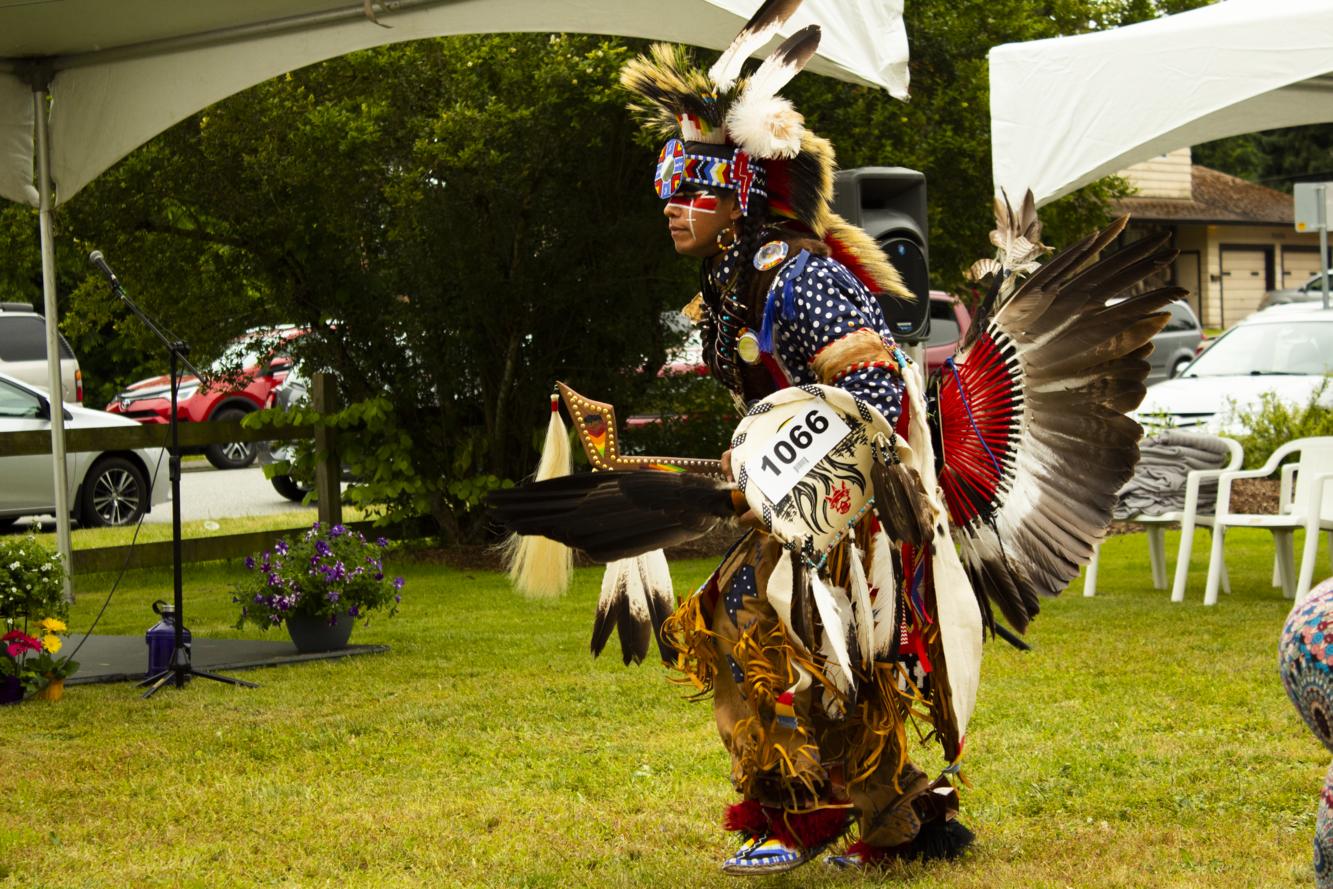For the past four years, Abbotsford has been home to the unique Aboriginal Arts and Culture Day, which offers an opportunity for people in the community to get engaged and learn about important local history. This year’s event was hosted at Trethewey House Heritage Site in Abbotsford on Sunday, June 9. Event coordinator Tery Kozma envisioned this event four years ago, and with the help of her daughter and fellow event coordinator Tara-Lynn Kozma-Perrin has been able to make this event a success.
“Realistically, there wasn’t a lot of opportunity for people to engage with the Indigenous community in a way that was comfortable for both parties,” said Kozma-Perrin.
Aboriginal Arts and Culture Day offers a great educational opportunity for people in the community to get together and learn about one another.
“It’s uncomfortable for anybody to walk into somebody else’s community or culture and ask questions; you don’t know what the proper protocol is either way, so that’s what we wanted to be able to provide,” said Kozma-Perrin.
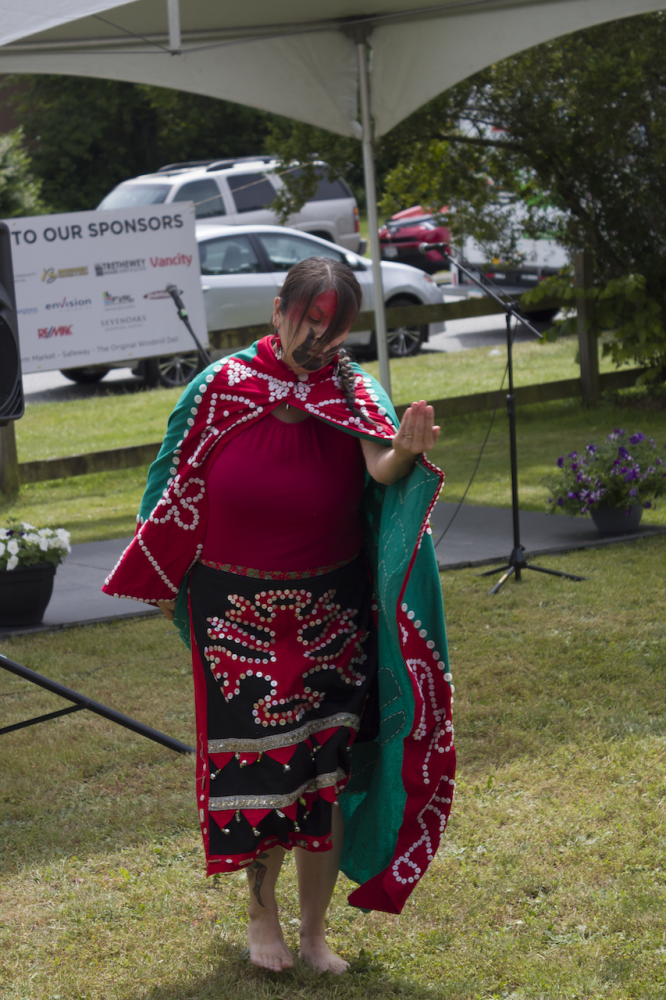 Each year the coordinators pick an important topic for the event. This year’s topic was missing and murdered Indigenous women and girls, and survivors of the Sixties Scoop, where many Indigenous children were “scooped” from their homes and placed them in foster care. These important topics were chosen with great care and were based off the Canadian government’s recently published Reclaiming Power and Place: The Final Report on the National Inquiry into Missing and Murdered Indigenous Women and Girls. The report illustrates Indigenous rights violations and the resulting violence against Indigenous women, girls, and 2SLGBTQQIA people that continues to occur throughout Canada.
Each year the coordinators pick an important topic for the event. This year’s topic was missing and murdered Indigenous women and girls, and survivors of the Sixties Scoop, where many Indigenous children were “scooped” from their homes and placed them in foster care. These important topics were chosen with great care and were based off the Canadian government’s recently published Reclaiming Power and Place: The Final Report on the National Inquiry into Missing and Murdered Indigenous Women and Girls. The report illustrates Indigenous rights violations and the resulting violence against Indigenous women, girls, and 2SLGBTQQIA people that continues to occur throughout Canada.
“The Final Report [has] testimony from family members and survivors of violence [and speaks] about a surrounding context marked by multigenerational and intergenerational trauma and marginalization in the form of poverty, insecure housing or homelessness, and barriers to education, employment, health care, and cultural support,” the report states.
Kozma and Kozma-Perrin felt it was an important opportunity to engage in conversations with the community.
“Our topic is definitely heavier, but we have been slowly planting seeds each year, leading up to something where we can have these deep conversations with our community in a respectful and inclusive way,” said Kozma-Perrin. “This is the first year that we are actually able to provide people funding as to what [the artisans] would actually get paid if they went to an event. It’s all because of the grant we got from the missing and murdered Indigenous women and girl’s inquiry. Without them we wouldn’t be able to do what we are doing this year.”
This year’s Aboriginal Arts and Culture day welcomed families of survivors and those who have been affected, offering resources and hosting closed workshops, one of which, organized by Sacred Teachings, was called Living your Passions and focused on self-healing. Many other resources were available not only for these honoured guests, but also for others attending the event.
Kozma partnered with Heritage Abbotsford Society in 2018 and the event has been held at Trethewey House ever since. Christina Reid, executive director of the Heritage Abbotsford Society, has been going to the event since its inception in 2015. In previous years Kozma held the event with the Abbotsford Arts Council at the Kariton Gallery, but as the event grew, there was a need for more space. When Kozma reached out to Reid in search of a new location, Reid knew this would be a good partnership.
“Our mission statement is to be the memory of the community, and that’s supposed to be all of the community,” said Reid.
The first time they ran the event four years ago, with the spirit of reconciliation and education in mind, Kozma and Kozma-Perrin went door to door canvassing for artisans.
“In the first year we were knocking on people’s doors and going to all the reserves, the band office, and the friendship centres trying to find artisans and performers who basically wanted to come here for free,” said Kozma-Perrin.
They didn’t have any funding in the first year and Kozma remembers spending $998 out of pocket to host the event. Since then they have gained many partners in the community who have come together to help put on the event. Kozma recognized Vancity for their support from day one, as well as many other local businesses who have pledged their support over the years, including Fraser Valley Regional Library, Abbotsford Community Foundation, The Windmill Deli, and Panago Pizza. Kozma-Perrin expressed her excitement in having the Aboriginal Genealogy Association and the First Nations Health Authority participate in this year’s event.
The pre-event kickoff, Indigenous Performers Night, was hosted by the Abbotsford Arts Council on Saturday, June 8 and marked the start of a concert series they will be hosting throughout the summer in Mill Lake Park. Dakk’One, an Indigenous hip-hop artist from Saskatoon, performed along with Chris Silver, dance group Butterflies in Spirit, and Rudegang Entertainment. The Kariton Gallery is also currently presenting the Indigenous Awareness Art Exhibition which their website states is an opportunity for the Fraser Valley community to learn more about Indigenous culture and history.
“We had a lot of wonderful artisans and performers that actually came and did it for free and have been with us since the beginning. It’s been wonderful to slowly get more grants so that we can actually pay artisans and performers what they deserve to be paid, so that we are actually giving back to the community,” said Kozma-Perrin.
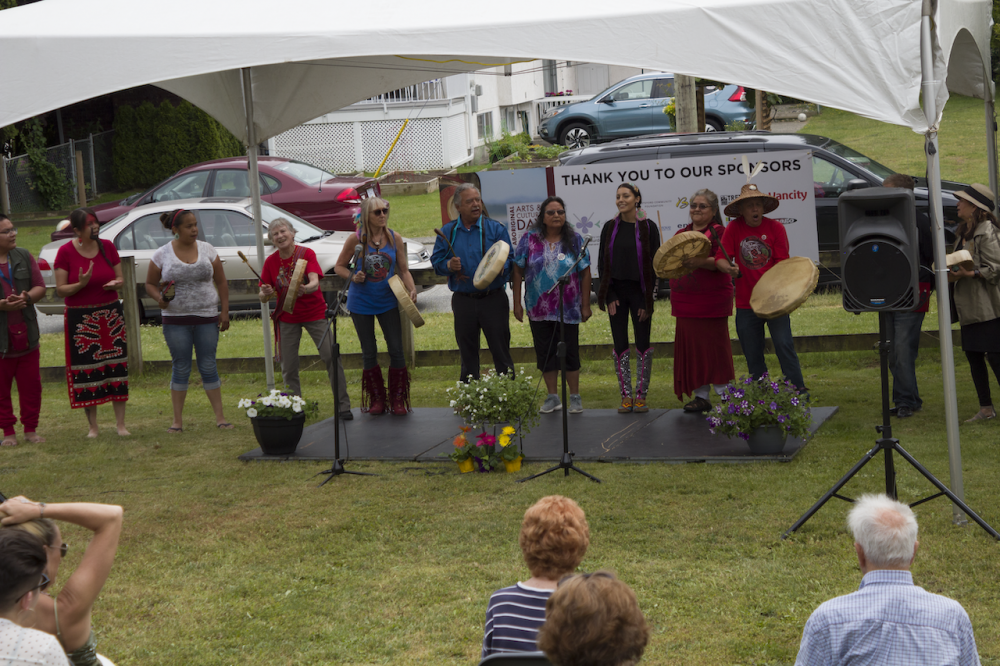
On Sunday, councillor Chris Silver of Sumas Nation, along with Pixie Wells, emceed the Aboriginal Arts and Culture Day. Performances included singing by Elder Kelly White of the Musqueam Nation, who has been gifted the women’s warrior song. White sang in honour of the missing and murdered Indigenous women and girls. Other performances included Peter White, a traditional dancer from the Ktunaxa Nation. Many attendees wore the mark of a hand covering their mouth representing the topic of missing and murdered Indigenous women and girls.
“[The issue of missing and murdered Indigenous women and girls] really bothered me … and how it’s been ignored and [now] there’s the inquiry … I really want to bring this to face in Abbotsford, because a lot of people don’t even know what it is. The hand over the mouth is an image for the people who didn’t get to speak,” said Kozma.
Many important information booths were available, including one for the Aboriginal Genealogy Network. The network works with those who wish to find more information on their family history. Volunteers Agnes Giesbrecht and Lola Hawk have been working with the organization for years helping families learn more about their family tree. Their booth allowed visitors to look through the archives with the volunteers and see if they could connect some family ties together on site at the event.
“A lot of folks who are dropping in are looking to either start their family search or enhance it [to] connect some more dots,” said Hawk.
The First Nations Health Authority, who were also present, assist members of First Nations communities in accessing health care and aim to create accessible information and resources. Their community relations representative, James Delorme, had an abundance of information and fliers about the upcoming changes within health services for First Nations peoples.
“Our goal is improved services, less wait times, less predeterminations, and a greater increase of services for First Nations clients,” said Delorme.
Other booths were raising awareness for related social issues, one of which was Protect our People. The grassroots movement was co-founded by Dakota Bear and Casey Desjarlais.
Bear said that the organization focuses on raising awareness and taking action against human trafficking within Canada.
“A lot of people believe this happens internationally, but that’s human smuggling. [With] human trafficking, 95 per cent of the cases are actually within our own borders of our country,” said Bear.
Their research showed that there were 140 long lasting missing persons cases in Saskatchewan alone. They’re currently pushing toward a petition to implement mandatory health services training for human trafficking; the petition has around 16,000 signatures.
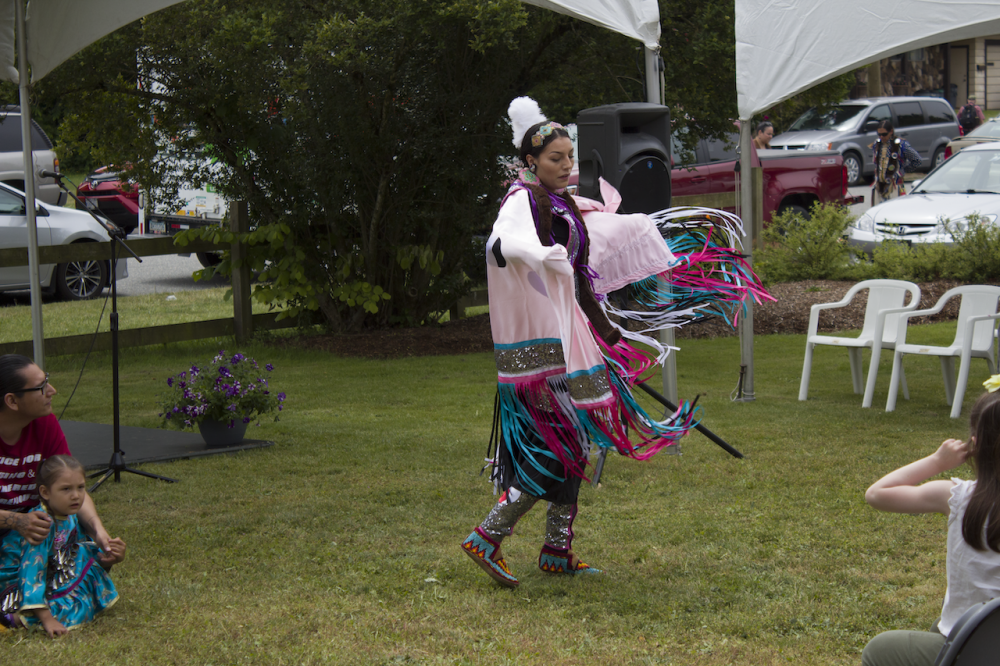
Many other booths focused on educational components, centred around history and the arts. The artisan’s booths had everything from blankets, to t-shirts, to other traditional artwork. Cowichan Coast Salish artist Darrel A. Thorne presented a series of contemporary Salish artworks. Other booths had everything from silver carving to natural traditional remedies. For many different vendors and people, the focus was on opening conversations and celebrating their arts and culture.
“That’s really what it’s all about: how do we create these partnerships with everyone so we are all working toward the same goal, which is education and reconciliation,” said Kozma-Perrin.
University of the Fraser Valley’s (UFV) resident Elder, Eddie Gardner, was at the event speaking for and supporting the Wild Salmons Defender’s Alliance, an organization that “strongly advocates for the removal of industrial open-net pen salmon farms from the migration routes of wild salmon in British Columbia.” Gardner’s role at UFV is primarily providing support for the Indigenous students who attend the university and providing spiritual guidance and information about the local Stó:lo culture. Gardner provides support for students inquiring about the Indian Residential School legacy, Indigenous rights and title, the United Nations Declaration of the Rights of Indigenous People, and other important issues.
“I help orientate the Indigenous students to the sweat lodge or to find out more about the longhouse, or about the medicine wheel … sometimes the professors ask us to come in and talk as well about Indigenous history,” said Gardner.
Throughout the day attendees also had the opportunity to participate in workshops, such as drum-making. The workshop held by Darren Charlie, a drum maker from the Sts’ailes Indian Band, allowed each person to learn about the process and ask questions about the drum’s purpose.
Attendees were also able to get food and drinks and settle in to watch the performers. The Stó:lo Bannock truck was also a huge hit, along with Spirit Bear coffee.
The main stage was home to many performers throughout the day, honouring guests and Elders in attendance. As the day came to a close, traditional dancer Peter White performed multiple dances, one known as “The Duck and Dive.”
“This song, when I dance it out of respect for the Nez Perce people, I will ask you to rise and honour the soldiers that have fallen,” said White, in recognition of the 75th anniversary of D-Day.
White travels and competes throughout the summer at various Pow Wows, and as he danced the audience was silent and respectful. White’s performance marked the end of the event as he moved into a “Round Dance,” which is a friendship dance that is performed during the winter in the Prairies where participants form a circle meant to represent friendship. Volunteers, attendees, and honorary guests joined hands and danced, and it seemed that the purpose of the event — community, education, and reconciliation — was embodied in the joining of hands.
Honouring the coordinator and visionary behind this event, Silver presented Kozma with a ribbon skirt from the council. This wrapped up the event and thanks were given to everyone who attended. Events like this open communication pathways in the community by facilitating connections and providing an environment for people to ask questions in a safe and respectful way.
“It’s so cool to be able to have this information for people to access, and for Indigeneous and non-Indigenous to be able to come together and learn at the same time,” said Kozma-Perrin.
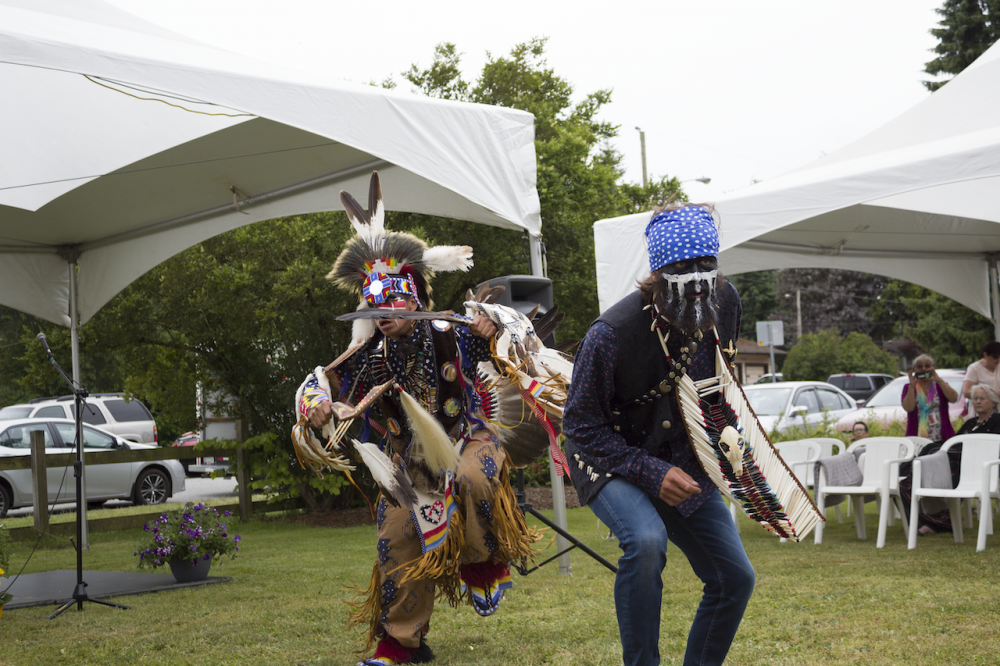
Images: David Myles/The Cascade

